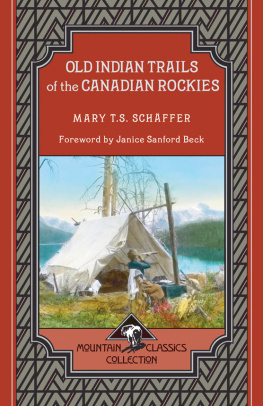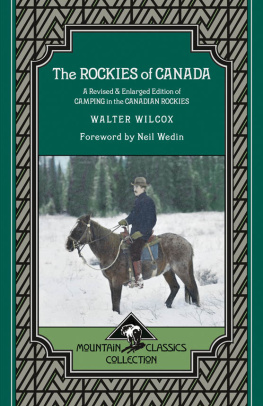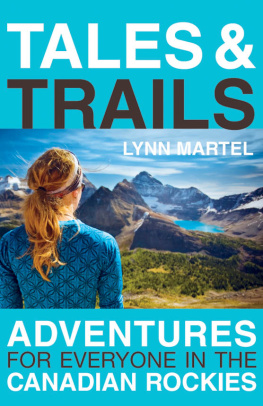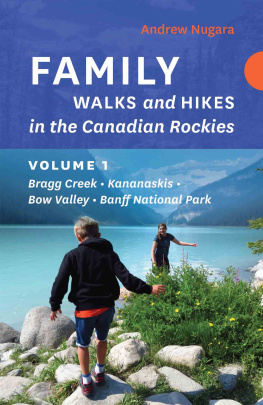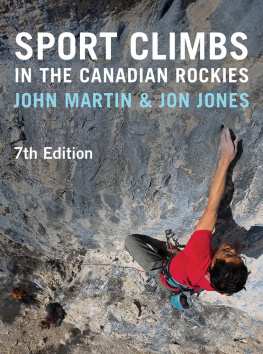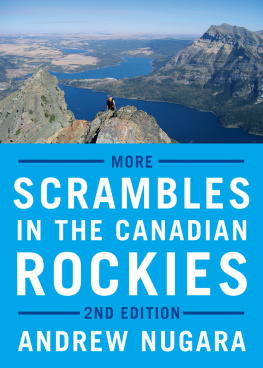Chapter I
An Explanation
Twenty years ago, 99 percent of the tourists to the section of the Rockies of Canada mentioned in these pages flitted across the country as bees across a flower garden, and were gone.
There were comparatively few of them, and but a small modicum of enthusiasm distributed among them. Banff contained a hostelry which swallowed all who came and left few visible (so small was the number); Lake Louise boasted no hotel at all, we slept in tents in 1893, and from our door looked out upon that magnificent scene with chattering teeth and shivering bodies and vowed never again to camp in the Canadian Rockies; Field, with her splendid drives and trails and Yoho Valley today, was an insignificant divisional point and eating station; Glacier, a tiny picturesque chalet cuddled close to the railroad track as though to shield her from the dark forests behind her, was full to the brim if so many as a dozen stopped off to view the one sight of those days, the Great Glacier.() only seven miles away, hidden and unknown in an even more fascinating valley.
However, over an infinitesimally few those mountains had thrown a glamour and a spell so persistent and so strong, that with the first spring days, no matter where they be, warm breezes brought the call, Come back, come back to the blue hills of the Rockies!
And we went; went year by year; watched the little chalets grow, watched the pushing of the trails into new points of interest, watched with veiled and envious eyes our secret haunts laid bare to all who came. And they did come, fast and furious! Steam heat and hot and cold water had done their work. The little tents on the shores of Lake Louise, with their balsam-bough beds and an atmosphere reeking with health and strength to those weary with the citys life, were banished and only found again by the determined few who had heard of the discovered Moraine Lake, Lakes OHara and McArthur, and Ptarmigan and Yoho valleys. Point by point we fled to them all, each one of them a stronghold at civilizations limits, each one of them a kindergarten of the at-first-despised camping life. In them we learned the secret of comfort, content and peace on very little of the worlds material goods, learned to value at its true worth the great un-lonely silence of the wilderness and to revel in the emancipation from frills, furbelows and small follies.
But the tide swept on. With jealous eyes we watched the silence slipping back, the tin cans and empty fruit jars strew our sacred soil, the mark of the axe grow more obtrusive, even the trails cleared of the dbris so hard to master, yet so precious from the fact it must be mastered to succeed.
Where next? Driven from our Eden, where should our tents rise again? We were growing lost and lonesome in the great tide which was sweeping across our playground, and we longed for wider views and new untrammelled ways. With willing ears we listened to the tales brought in by the hunters and trappers, those men of this land who are the true pioneers of the country in spite of the fact that they have written nothing and are but little known. With hearts not entirely on pelts, they had seen and now told us of valleys of great beauty, of high unknown peaks, of little-known rivers, of un-named lakes, lying to the north and northwest of the country we knew so wella fairyland, yet a land girt about with hardships, a land whose highway was a difficult trail or no trail at all. We fretted for the strength of man, for the way was long and hard, and only the tried and stalwart might venture where cold and heat, starvation and privation stalked ever at the explorers heels. In meek despair we bowed our heads to the inevitable, to the cutting knowledge of the superiority of the endurance of man and the years slipped by.
From the States came Allen and Wilcox, (men of course), who gathered their outfits together and left us sitting on the railroad track following them with hungry eyes as they plunged into the distant hills; to listen just as hungrily to the campfire tales on their return of all the wonders of the more northern Rockies; came Stutfield, Collie, Woolsey, Outram (names so well known in the alpine world today), to tell again to our eager listening cars of the vast, glorious, unexplored country beyond; came Fay, Thompson, and Colemanall men!
There are few women who do not know their privileges and how to use them, yet there are times when the horizon seems restricted and we seemed to have reached that horizon, and the limit of all enduranceto sit with folded hands and listen calmly to the stories of the hills we so longed to see, the hills which had lured and beckoned us for years before this long list of men had ever set foot in the country. Our cups splashed over. Then we looked into each others eyes and said: Why not? We can starve as well as they; the muskeg will be no softer for us than for them; the ground will be no harder to sleep upon; the waters no deeper to swim, nor the bath colder if we fall insowe planned a trip.
But instead of railing at our predecessors, we were to learn we had much for which to thank them. Reading the scanty literature which dealt with their various expeditions, we had absorbed one huge fundamental fact almost unconsciously, viz.that though this was a land of gameof goat, sheep, bear, deer and caribou, one might pass through the country for days yet see no signs of wildlife. Fish there are in plenty, yet for weeks, when the summer sun melts everything meltable, and the rivers are clouded with silt from the glaciers, they will not rise to the most tempting bait, and the grouse disappear as though by magic.
Throughout the limited literature ran this simple ever-present facta beautiful, but inhospitable land, and the cause of many an unfinished or abandoned expedition and a hasty retreat to the land of bread-and-butter.
Thanking our informants for their unconscious hint, we laid our plans both long and deep. Our initial experience of one nights camp on the shores of Lake Louise, when we had felt frozen to the bone and had at the time promised ourselves never to do such a trick again, had been augmented by a flight of three days to Yoho Valley when it wasnt Yoho Valley, only a lovely unknown bit of country, another chilly experience at Moraine Lake, a pause, then a week in the Ptarmigan Valley, and later a sortie of five weeks in the Saskatchewan country. In these trips we had gathered a few solid facts; surely with them we were more or less prepared for a whole summer in the country of which so little was known.
In spite of the protests of anxious relatives and friends, our plans were laid for a four-month trip during the summer of 1907, and a vow made not to return till driven back by the snows.
The guide-in-chief () was our most important factor. To whom should we more naturally turn than to him who had watched over us in the days of our camp swaddling clothes, who had calculated the amount of our first camp fare, given us our first lessons in camp comforts, and in fact our very first lessons in sitting astride a horse and learning to jump a log without being shot over the head of our steed?
Three years acquaintance had taught us his value, and as he did not turn us down, but kindly spurred us on in our undertaking and cheerfully assumed the leadership, he made us feel we had worn a considerable amount of the tenderfoot from our compositions. Having always kept a strict account of the amount of food he had packed over the trails for us on our shorter expeditions, it became a mere matter of arithmetic for a longer one. If so many pounds of bacon lasted us seven weeks, how many pounds of bacon would last 16 weeks?and so through the entire gamut of the food supplyflour, baking-powder, cocoa, coffee, tea, sugar, dried fruits, evaporated potatoes, beans, rice, etc.with a weeks extra rations thrown in for emergency.

